April 29, 2011 — Electrical engineers at the University of Michigan have built an energy harvester that can harness energy from vibrations and convert it to electricity with five to 10 times greater efficiency and power than other devices in its class. And it’s smaller than a penny.
 |
|
Photo. A new energy harvester developed by University of Michigan researchers can harness energy from vibrations and convert it to electricity with five to ten times greater efficiency and power than other devices in its class. Credit: Erkan Aktakka |
"In a tiny amount of space, we’ve been able to make a device that generates more power for a given input than anything else out there on the market," said Khalil Najafi, one of the system’s developers and chair of Electrical and Computer Engineering.
The researchers have built a complete system that integrates a high-quality energy-harvesting piezoelectric material with the circuitry that makes the power accessible. Piezoelectric materials allow a charge to build up in them in response to mechanical strain, which in this case would be induced by the machines’ vibrations.
A novel silicon micromachining technique allows the engineers to fabricate the harvesters in bulk with the high-quality piezoelectric material, unlike other competing devices.
The active part of the energy harvester that enables the energy conversion occupies just 27mm2. The packaged system, which includes the power management circuitry, is in the size of a penny. The system has 14 Hertz bandwidth and operates at a vibration frequency of 155 Hertz, similar to the vibration you’d feel if you put your hand on top of a running microwave oven.
|
Also read:
|
"Most of the previous vibration energy harvesters operated either at very high frequencies or with very narrow bandwidths, and this limited their practical applications outside of a laboratory environment," Aktakka said.
The new harvester can generate more than 200 microwatts of power when it is exposed to 1.5g vibration amplitude. (1g is the gravitational acceleration that all objects experience by Earth’s gravity.) The harvested energy is processed by an integrated circuitry to charge an ultracapacitor to 1.85 volts.
In theory, these devices could be left in place for 10 or 20 years without regular maintenance. "They have a limitless shelf time, since they do not require a pre-charged battery or an external power source," Aktakka said.
The researchers will present this work next at the 16th International Conference on Solid-State Sensors, Actuators, and Microsystems (TRANSDUCERS 2011) in Beijing in June. This research is funded by the Defense Advanced Research Projects Agency (DARPA) and National Nanotechnology Infrastructure Network. The university is pursuing patent protection for the intellectual property, and is seeking commercialization partners to help bring the technology to market.
Learn more at http://www.umich.edu/
Follow Small Times on Twitter.com by clicking www.twitter.com/smalltimes. Or join our Facebook group

